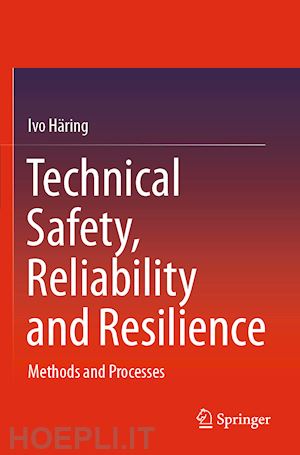
Questo prodotto usufruisce delle SPEDIZIONI GRATIS
selezionando l'opzione Corriere Veloce in fase di ordine.
Pagabile anche con Carta della cultura giovani e del merito, 18App Bonus Cultura e Carta del Docente
1 Introduction and objectives
1.1 Safe, secure and resilient technical sustainable systems
1.2 Structure of text and chapter contents overview
1.3 Main features of the text
1.4 Sample background research projects
1.4.1 Functional safety of heating and cooling systems in electical vehicles
1.4.2 Resilience Engineering of multi-modal indoor localization system
1.4.3 Reliabilty and resilience for local power supply grids
2 Technical safety and reliability methods for resilience engineering
2.1 Overview
2.2 Why to leverage classical system analysis approaches for resilience engineering
2.3 Approach to assess the suitability of methods
2.4 Suitability assessment with five-step risk management scheme
2.5 Method Usability assessment using Resilience responSe cycle time phases
2.6 Method Usability assessment using Technical resilience capabilities
2.7 Method Usability assessment using system layers
2.8 Method Usability assessment using Resilience criteria
2.9 Summary and conclusions
2.10 Questions
2.11 Answers
3 Basic technical safety terms and definitions
3.1 Overview
3.2 System
3.3 Life cycle
3.4 Risk
3.5 Acceptable risk
3.6 Hazard
3.7 Safety
3.8 Risk minimization
3.9 Safety relevant and critical systems
3.10 Safety relevant norms
3.11 Systems with high requirements for the reliability
3.12 Models for the software and hardware development process
3.13 Safety function and integrity
3.14 Safety Life Cycle
3.15 Techniques and measures for achieving safety
3.16 System description, system modeling
3.16.1 OPM (Object Process Methodology)
3.16.2 AADL (Architecture Analysis & Design Language)
3.16.3 UML (Unified Modeling Language)3.16.4 AltaRica / AltaRica DF
3.16.5 VHDL (Very High Speed Integrated Circuit Hardware Description Language)
3.16.6 BOM (Base Object Model)
3.16.7 SysML (Systems Modeling Language)
3.17 System simulation
3.18 System analysis methods
3.19 Forms of documentation
3.20 Questions
3.21 Answers
4 Introduction to system analysis
4.1 Overview
4.2 Definition of a system
4.3 Boundaries of the system
4.4 Theoretical vs. practical system audit
4.5 Inductive and deductive system analysis methods
4.6 Forms of documentation
4.7 Failure space and success space
4.8 Overview diagram
4.9 Black swans
4.10 Failure and fault
4.11 Types of failures
4.12 Safety and reliability
4.13 Redundancies
4.14 Active and passive components
4.15 Standby
4.16 Optimization of resources
4.17 Combination of failures
4.18 Summary and outlook
4.19 Questions
4.20 Answers
5 Introduction to system analysis methods
5.1 Overview5.2 Parts Count approach
5.3 FMEA
5.4 FMECA
5.5 FTA
5.6 ETA
5.7 HA
5.8 FHA
5.9 DFM
5.10 Summary and Outlook
5.11 Questions
5.12 Answers
6 Fault Tree Analysis
6.1 Overview
6.2 Introduction to Fault Tree Analysis
6.3 Definitions
6.3.1 Basic event and top event
6.3.2 Cut sets, minimal cut sets, and their order
6.3.3 Multiple occurring events and branches
6.3.4 Exposure time
6.4 Process of Fault Tree Analysis
6.5 Fundamental concepts
6.5.1 The I-N-S concept
6.5.2 The SS-SC concept
6.5.3 The P-S-C concept
6.6 Construction rules
6.7 Mathematical basics for the computation of Fault Tree
6.8 Computation of minimal cut sets
6.8.1 Top-Down method
6.8.2 Bottom-Up method
6.9 Dual Fault Trees
6.10 Probability of the top event
6.11 Importance measures6.11.1 Importance of a minimal cut set
6.11.2 Top contribution importance
6.11.3 Risk Reduction Worth (RRW)
6.11.4 Risk Achievement Worth (RAW)
6.11.5 Birnbaum importance measure 1
6.12 Extensions of classical Fault Tree Analysis
6.12.1 Time- and mode-dependent Fault Trees
6.12.2 Dynamic Fault Tree Analysis6.12.3 Dependent basic events
6.12.4 Fuzzy probabilities
6.13 Summary and outlook
6.14 Questions
6.15 Answers
7 Failure Modes and Effects Analysis
7.1 Overview7.2 Introduction to FMEA
7.2.1 General aspects of the FMEA method
7.2.2 FMEA application options
7.2.3 Sorts of FMEA
7.3 Execution of an FMEA
7.3.1 Preparation
7.3.2 Step 1: Structural analysis
7.3.3 Step 2: Functional analysis7.3.4 Step 3: Failure analysis
7.3.5 Step 4: Measure analysis (semi-quantification)
7.3.6 Step 5: Optimization
7.4 FMEA form sheet
7.4.1 Introduction
7.4.2 Columns
7.5 Evaluation table
7.6 RPN
7.7 Probability of default7.8 Norms and standards
7.9 Extensions of classical FMEA
7.9.1 Weighting and risk factors
7.9.2 Feasibility assessment
7.9.3 Risk map
7.9.4 FMECA
7.9.5 FMEDA
7.10 Relation to other methods
7.11 Disadvantages of FMEA
7.12 Summary and outlook
7.13 Questions
7.14 Answers
7.15 An example of FMEDA
7.15.1 Overview
7.15.2 System description
7.15.3 Task
8 Hazard analysis
8.1 Overview
8.2 General aspects
8.3 Hazard Log
8.4 Preliminary Hazard List
8.5 Preliminary Hazard Analysis
8.6 Subsystem Hazard Analysis
8.7 System Hazard Analysis
8.8 Operating and Support Hazard Analysis
8.9 Comparison of the Hazard Analysis worksheets8.10 Evaluation of risks
8.10.1 Risk map
8.10.2 Risk graph
8.10.3 Computation of SIL
8.11 Allocation of the different types of hazard analysis to the development cycle
8.12 Standardization process
8.13 Tabular summary of use of different types of tabular analyses
8.14 Additional material
8.15 Questions
8.16 Answers
9 Reliability prediction
9.1 Overview
9.2 Reliability and dependability
9.3 Embedding “reliability prediction” into the range of system analysis methods
9.3.1 Failure modes analysis9.3.2 Reliability prediction
9.3.3 System state analysis
9.4 Software
9.5 Failure
9.6 Demand modes for safety functions
9.7 Failure density
9.8 Failure rate
9.9 Bathtub curve
9.10 Standards
9.10.1 General design
9.10.2 MIL-HDBK-217
9.10.3 SN29500 (Siemens)
9.10.4 Telcordia
9.10.5 217-Plus
9.10.6 NSWC
9.10.7 IEC TR 62380
9.10.8 IEEE Gold Book (IEEE STD 493-1997)
9.10.9 SAE (PREL 5.0)
9.10.10 GJB/Z 299B9.10.11 FIDES
9.11 Summary and outlook
9.12 Additional material
9.13 Questions
9.14 Answers
10 Models for hardware and software development processes
10.1 Overview
10.2 Properties of the software development mod











Il sito utilizza cookie ed altri strumenti di tracciamento che raccolgono informazioni dal dispositivo dell’utente. Oltre ai cookie tecnici ed analitici aggregati, strettamente necessari per il funzionamento di questo sito web, previo consenso dell’utente possono essere installati cookie di profilazione e marketing e cookie dei social media. Cliccando su “Accetto tutti i cookie” saranno attivate tutte le categorie di cookie. Per accettare solo deterninate categorie di cookie, cliccare invece su “Impostazioni cookie”. Chiudendo il banner o continuando a navigare saranno installati solo cookie tecnici. Per maggiori dettagli, consultare la Cookie Policy.